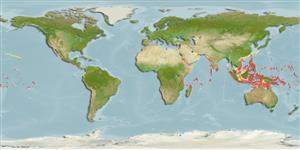Actinopterygii (ray-finned fishes) >
Perciformes (Perch-likes) >
Labridae (Wrasses) > Cheilininae
Etymology: Oxycheilinus: Greek, oxys = sharp + Greek, cheilos = lip.
Environment / Climate / Range
Ecology
Marine; reef-associated; depth range 25 - 60 m (Ref. 90102), usually 30 - ? m (Ref. 9823). Tropical, preferred ?; 30°N - 15°S
Indo-Pacific: Red Sea to the Marshall Islands and Samoa. Western Indian Ocean: Mozambique (Ref. 41878).
Size / Weight / Age
Maturity: Lm ? range ? - ? cm
Max length : 21.0 cm TL male/unsexed; (Ref. 90102)
Dorsal
spines
(total): 9;
Dorsal
soft rays
(total): 10;
Anal
spines: 3;
Anal
soft rays: 8 - 11. Recognized by the thin mid-lateral stripe and elongated blotch at front of dorsal fin between 1st and 3rd spines (Ref. 48636). Body covered with relatively large scales; large canine teeth in the front of jaws.
Found solitary (Ref. 90102) in caves of steep outer reef drop-offs from 25 to at least 46 m (Ref. 1602) with rich invertebrate growth such as large gorgonians or soft corals (Ref. 48636). Feeds mainly on fishes, shrimps and other crustaceans (Ref. 9823).
Life cycle and mating behavior
Maturity | Reproduction | Spawning | Eggs | Fecundity | Larvae
Oviparous, distinct pairing during breeding (Ref. 205).
Westneat, M.W., 2001. Labridae. Wrasses, hogfishes, razorfishes, corises, tuskfishes. p. 3381-3467. In K.E. Carpenter and V. Niem (eds.) FAO species identification guide for fishery purposes. The living marine resources of the Western Central Pacific. Vol. 6. Bony fishes part 4 (Labridae to Latimeriidae), estuarine crocodiles. FAO, Rome. (Ref. 9823)
IUCN Red List Status (Ref. 115185)
CITES (Ref. 94142)
Not Evaluated
Threat to humans
Harmless
Human uses
Fisheries: minor commercial
More information
ReferencesAquacultureAquaculture profileStrainsGeneticsAllele frequenciesHeritabilityDiseasesProcessingMass conversion
Tools
Special reports
Download XML
Internet sources
